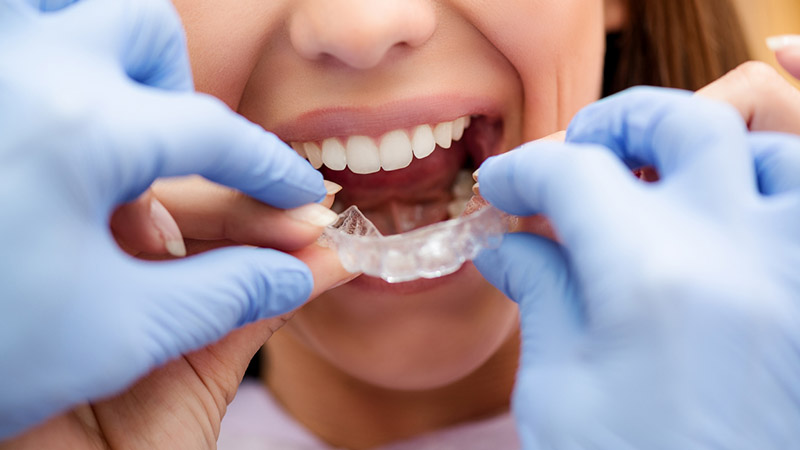Simply put, there is actually no age limit for someone to get braces. According to the American Association of Orthodontists, there is a high number of patients fitted with dental braces every day over the age of 18. Typically, the only requirements dental professionals have is a healthy jaw bone and permanent teeth. However, adults who are looking to correct their dental misalignments with braces should read on for additional requirements and alternatives to wearing traditional metal braces.
What Adults Should Know Before Getting Braces
While younger patients only need to have a complete set of permanent teeth before they are fitted with dental braces, there are several requirements that need to be met so adults can have the same success with braces.
- Strong Teeth and Jaws are Important
You can still be fitted with dental braces as an adult, provided that you have a healthy set of teeth and a normal jaw bone. Orthodontists and other experts recommend this to avoid unwanted consequences such as jaw issues, gum disease, or tooth decay. - Some Misalignments Are More Complicated
Adult teeth have reached a point in which they have stopped growing, making it harder to correct more severe misalignments. Some structural changes cannot be accomplished with just braces alone, and orthodontic treatment may also require oral surgery to achieve the same results as a child or adolescent. Of course, cases vary from patient to patient and are not always a direct result of a person’s age. - Treatment May Involve More than Orthodontics
Adults seeking any orthodontic treatment may find that there are other dental issues that need to be treated before braces can be installed. For example, you may be referred to a periodontist if you’re at risk for gum disease or it’s determined you have gum disease already. You may also need a filling, root canal, or other dental treatments in preparation for braces if you’ve been neglecting your oral hygiene as an adult.
Despite these requirements, studies found that correcting adult teeth using braces is often just as successful when compared to their younger counterparts. The high success rate is driven by the fact that adults tend to be more compliant to the advice and instructions of their dentists, orthodontists, and other medical professionals. Generally, adults looking to get braces also exercise more consistent oral hygiene than those who do not value a healthy smile.
Why Some Adults Choose to Skip Braces
Unfortunately, there are other factors that tend to persuade adults into avoiding braces altogether. While some are pure misconceptions and lack of understanding, there are also those who opt out for social and personal reasons. However, new developments and technologies in orthodontics have lessened the impact of the following issues.
- Physical and Social Inconvenience
Given that braces are more commonly seen in children or adolescents, adults tend to be uneasy with the idea of wearing bulky dental braces. The fear of being judged is one of the most common reasons adults avoid using braces to correct their teeth. However, there have been developments that have improved the design of braces, making them more discreet. Some braces are less intrusive and almost invisible. We’ll discuss these options in detail. - Lifestyle and Diet Changes
Adults are also worried about changes to their diets and lifestyle once they are fitted with dental braces. It’s true, avoiding certain foods is essential when wearing braces to prevent staining your teeth or damaging the brackets and wires. Although this may be a slight inconvenience at first, most patients become accustomed to their new eating habits fairly quickly. It’s also important to remember that braces are not permanent and will eventually be removed. Overall, it’s a small price to pay for a lifetime of a perfectly straight smile. - Wearing Braces for An Extended Period of Time
Most adults do not have to wear braces any longer than an adolescent would in order to correct misalignments. Once you have your braces installed, you will be given instructions and best practices on how to care for them. If you follow these guidelines carefully, you can avoid having to wear the braces for longer than expected. Learn more about what to expect once you have braces so you are better prepared when they’re installed.
Other Orthodontic Options for Adults
If patients are unsure of which orthodontic option is best to avoid bulky metal braces, there are a few alternatives to consider, including clear braces, invisible braces like Invisalign, and lingual braces (less common). The following are some of the most popular choices for adults seeking to correct misaligned teeth.
- Clear Braces
Clear braces are a great alternative for people looking to minimize the appearance of their braces while still having comparable results to metal braces. While clear braces are similar to traditional braces, this option uses ceramic bonding to adhere to the teeth. The ceramic appears more natural in color, making it less noticeable when smiling. However, this solution is more prone to teeth staining if you do not practice proper dental care. - Invalisign
Invalisign is an orthodontic option that is proven to correct dental issues while being much more discreet than braces. Also known as invisible or plastic braces, Invisalign is made of clear, durable plastic rather than brackets, wires, and rubber bands seen in traditional braces. It is recommended for patients needing orthodontic treatment, but are unwilling to undergo significant changes to appearance or diet. The plastic Invisalign trays can be completely removed when eating, although they should not be kept out of the mouth for very long as the teeth will begin to shift back to their original positions.
Overall, patients are able to get braces well into adulthood, given they have a healthy mouth and strong jaw bone. The stigma surrounding traditional metal braces has led to orthodontic advancements and several alternatives that allow adults to correct their teeth more privately. When practicing good oral hygiene, adults are perfect candidates for braces in most cases. If you’re ready to try braces, here are some things to consider when choosing an orthodontist.


